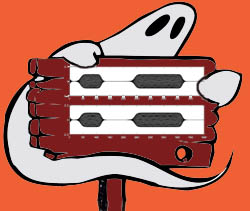
I transferred the foil blade to a drill vise and slid it along the floor. The amplitude of the blade movement peaked next to the desk, which was halfway down the room.
From the measurements, I formed the hypothesis that a low frequency (LF) standing wave of about 19 Hz with significant amplitude was the cause of this supernatural encounter.
Finding the source was easy. I asked the maintenance staff if any work had been done near our lab; indeed a fan had been installed the previous weekend.
Turning the fan off not only stopped the blade moving, but also lifted the oppressive feeling from the room and effectively exorcised the “ghost”, which was not reported again.
My interest in the effects of LF sound ignited. I dug out a work by W. Tempest from 1976, titled Infrasound and Low Frequency Vibration (Academic Press, London), which contained a couple of interesting case studies:
Noise consultants were asked to examine one of a group of bays in a factory where workers reported feeling uneasy. The bay had an oppressive feel not present in the adjacent areas, although the noise level appeared the same. Management workers and consultants were all aware of the unusual atmosphere, and on investigation it was found that LF sound was present at a slightly higher level than in other bays. However, the actual frequency of the offending noise was not obvious. The cause of the noise was a fan in the air conditioning system.
Workers in a university radiochemistry building experienced the same oppressive feeling together with dizziness when the fan in a fume cupboard was switched on. Conventional soundproofing had reduced the audible sound to the point where there was hardly any difference in the noise with the fan on as off. The situation affected some people so much that they refused to work in the lab. It was concluded that the LF component of the sound was responsible.
Symptomology
Infrasound can cause hyperventilation, which may lead to feelings of panic. At the same time panic can cause hyperventilation, so it is possible to establish a positive feedback loop, the final effects of which can be quite profound.
Other works suggest the mechanism for the physical manifestation could be the vibration of the eyeball, which has a resonant frequency around 20 Hz.
With help from parapsychologist Dr. Tony Lawrence, I published “The Ghost in the Machine” in a 1998 issue of Journal of the Society for Psychical Research. From the publicity, people began contacting me with their own experiences of similar ghosts: gray objects and feelings of a presence.
Unfortunately, I had limited resources, but when one group of experiences centered on a medieval cellar near Coventry University, it was too good to miss. I published a second paper on this topic in 2000, “Something in the Cellar”, also in the Journal of the Society for Psychical Research:
In 1997, a Coventry tour guide accompanied a Canadian journalist touring Britain into the [Coventry] cellar. He noticed that the journalist gave the appearance of being taken ill as he crossed the threshold of the room…The journalist described a feeling as if a balloon was being pushed between his shoulder blades and an intense feeling of a presence. Eventually he reported that the face of a woman seemed to be peering over his right shoulder. The guide was unable to feel or see anything but the visitor had become “ashen” and looked extremely unwell. The journalist exhibited the physical symptoms for some time before recovering.
